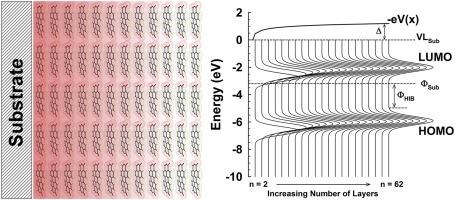We introduce extensions to a recently developed numerical model to understand the origin of universal Fermi level pinning of perylene-3,4,9,10-tetracarboxylic dianhydride (PTCDA) and its underlying mechanism. Our calculations are supported by ultraviolet and X-ray photoelectron spectroscopy to investigate the electronic structure of PTCDA on a wide range of substrates with different work functions and coupling interactions. For 20 nm thick layers of PTCDA, nearly unchanged hole injection barriers on all substrates are observed without any dependence on the type of substrate (unreactive, reactive or passivated metals and polymers). The simulation results demonstrate how the shape of the DOS near the interface has long-range influence on key parameters (e.g. the barrier to charge injection) of the entire organic film.

We introduce extensions to a recently developed numerical model to understand the origin of universal Fermi level pinning of perylene-3,4,9,10-tetracarboxylic dianhydride (PTCDA) and its underlying mechanism. Our calculations are supported by ultraviolet and X-ray photoelectron spectroscopy to investigate the electronic structure of PTCDA on a wide range of substrates with different work functions and coupling interactions. For 20 nm thick layers of PTCDA, nearly unchanged hole injection barriers on all substrates are observed without any dependence on the type of substrate (unreactive, reactive or passivated metals and polymers). The simulation results demonstrate how the shape of the DOS near the interface has long-range influence on key parameters (e.g. the barrier to charge injection) of the entire organic film.
